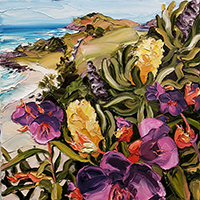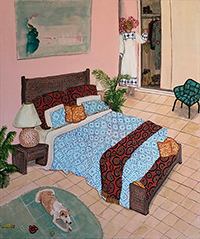Charles Blackman is one of Australia’s favourite iconic artists. An acute sense of emotional interplay between the viewer, the subject and the artist is at the center of his artworks. He is particularly renowned for his rendition of feelings and the feminine, showing up and focusing on particularities of the most tender and complex emotions that are difficult to express in any other way.

As an introduction to the new Tedder Avenue gallery, Anthea Polson Art presents a selection of limited-edition photographic artworks by the multi-awarded Samantha Everton. The unerring integrity of her photographic processes and an innate ability to access the subliminal in sumptuous visual narratives has won significant international acclaim for the Melbourne-based artist. Numerous series of works spanning 13 years have visually explored subjects “straddling dual worlds” in a quest for self-identity and transcendence amidst cultural variances.

Curious hybrid creatures, schematic figures and plant forms advance and submerge amidst linear markings and colourful geometric shapes. They personify Jill Lewis’s musings about the worlds within and around her. Akin to the intent and pictorial techniques employed by primitive and ancient cultures, the scenarios are invested with symbolism. “As in Egyptian frescoes, the size and position of the characters can be representative of their significance in my own imagined stories,” she imparts.

Secreted somewhere amidst tangles of filigreed foliage may lie the little tadpole and frog pond that was the inspiration for Robert Ryan’s intended new body of works. The pond and its creatures had been a chance discovery he’d made as a child during a brief roadside stop on a long journey. The rebuff of his plea to come see its wonders was his first inkling that he possessed an innate awareness of the ‘other’ shared by very few – the artist’s perspective!

Characterised by an intense involvement in the materiality of paint, Steve Tyerman’s works are the outcome of an intimate engagement with the environment. His art however, communicates a visual experience beyond the strictures of traditional landscape painting. Form, space, colour and light become simultaneously resolved in the immediacy of the palette knife gesture.

The title of the exhibition, As Days Go By, subtly references Martin Edge’s time in his Strathpine studio. The walls are aglow in a bright orange hue – his favourite colour since childhood – and bedecked in photos and clippings. An impressive collection of antique curios provides quiet company. Commenting on his experience of the recent lockdown he says, “It sometimes felt like I was stopped forever at a red traffic light and waiting for it to turn green! But my sense of humour is still going strong, painting makes me happy.” Martin’s vibrant works resonate with his sense of joie de vivre and optimism.

Gold Coast-based Erica Gray imparts that the current exhibition’s paintings and sculptures further her life.e.quatic series in celebrating the vivid colours, intricate patterning and structural complexities observed in a variety of marine creatures, coral formations particularly. Known as the ‘rainforests of the sea’, coral reefs have long been venerated by ancient civilizations for their alchemical, curative and ornamental properties.

Melbourne based artist Cathy Quinn is well recognised for her joyful fluid oil paintings. She creates abstracted landscapes taking pictorial cues from places visited. The artists outdoor scenes are grounded in familiar terrain, yet they are a combination of memories of place melded together to create her own world. She speaks about mood being an important aspect of these works and that time and place evoke the feeling and direction of the painting.

Art expression is a way of attempting to fathom the myriad chaotic inputs entering our consciousness from the everyday world and beyond. Perception, memory and experience may entwine in subsequent scenarios that defy a wholly logical explanation. Veronica Cay describes her collage works and ceramic sculptures as abstract vehicles to encourage reflection upon the human condition. Elucidating the title of her current exhibition, ‘the games that play us and dancing on the moon’, she tells how the altering of a familiar phrase ‘the games we play’ to ‘the games that play us’ connotes the powerful effect words can have on our viewing of a situation: ‘Currently it is becoming increasingly difficult to navigate for the truth of what is happening around us. Given the endless white noise bombarding the senses from so many sources, we may as well be dancing on the moon!’

Sydney-based Sophie Gralton’s new body of work aims to evoke a sense of integration between the past and the present and promote an awareness of the ever-evolving process towards individuation. Her signature imagery of an ‘isolated’ child is largely self-referential but intends a universal relevance. Gralton recounts that the initial inspiration for her oeuvre arose during a trip to Paris in 2007. There she became intrigued with Dutch 17th century portraits of children which were rendered as mini-adults and had hidden layers of meaning encoded in certain symbols and gestures.

Receive e-mail updates on our exhibitions, events and more
Subscribe Now